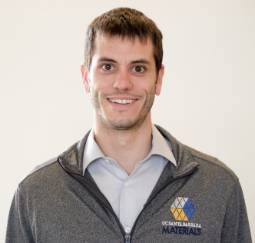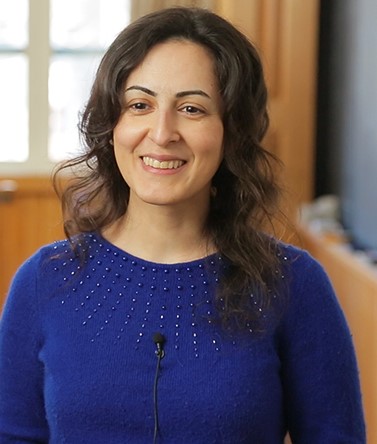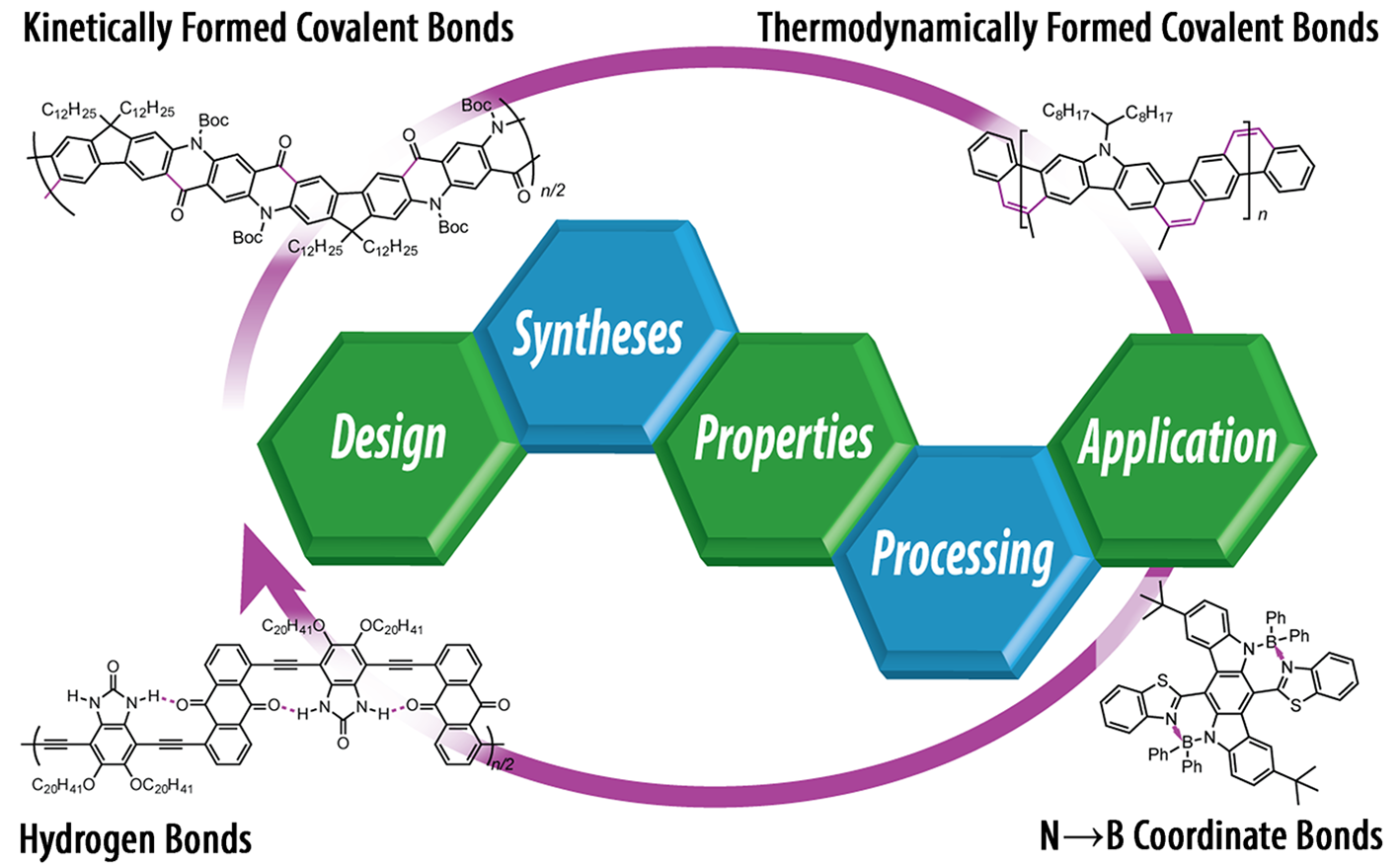School of Polymer Science and Engineering
Invited Seminars
Page Content
 Kendra Erk is an Associate Professor of Materials Engineering at Purdue University
in West Lafayette, Indiana. Before joining Purdue in 2012, she was a National Research
Council Postdoctoral Research Associate in the Polymers Division of the National Institute
of Standards and Technology (NIST, Gaithersburg, MD). She received her Ph.D. in 2010
from Northwestern University (Materials Science and Engineering) and her B.S. in Materials
Engineering in 2006 from Purdue University. Dr. Erk was the recipient of an NSF CAREER
Award in 2015 for her work on hydrogel-based internal curing agents for high-performance
concrete. The overall goal of Dr. Erk’s research at Purdue is to develop a better
understanding of important structure-property-processing relationships in a wide range
of soft materials and complex fluids with engineering relevance, from polymer hydrogels
to surfactant-oil-water emulsions. Characterizing the deformation and rheology of
the materials is of primary interest, with an emphasis on understanding molecular-level
phenomena through experimentation on model systems.
Kendra Erk is an Associate Professor of Materials Engineering at Purdue University
in West Lafayette, Indiana. Before joining Purdue in 2012, she was a National Research
Council Postdoctoral Research Associate in the Polymers Division of the National Institute
of Standards and Technology (NIST, Gaithersburg, MD). She received her Ph.D. in 2010
from Northwestern University (Materials Science and Engineering) and her B.S. in Materials
Engineering in 2006 from Purdue University. Dr. Erk was the recipient of an NSF CAREER
Award in 2015 for her work on hydrogel-based internal curing agents for high-performance
concrete. The overall goal of Dr. Erk’s research at Purdue is to develop a better
understanding of important structure-property-processing relationships in a wide range
of soft materials and complex fluids with engineering relevance, from polymer hydrogels
to surfactant-oil-water emulsions. Characterizing the deformation and rheology of
the materials is of primary interest, with an emphasis on understanding molecular-level
phenomena through experimentation on model systems.
@PurdueSoftMSE, http://soft-material-mechanics.squarespace.com/
Two major trends are in opposition, namely an increasing usage of polymeric materials
in packaging and home construction and increasing government restrictions on the usage
of common fire retardants. The latter include halogenated organics, long known for
their efficacy but now under scrutiny regarding toxicity. New approaches are urgently
needed to address the need for fire suppression formulations, either as additives
or coatings, which are environmentally acceptable and sustainable. Toward that end,
our laboratory has given increasing attention to intumescent coatings that can promote
a significant delay of combustion of, for example, cardboard and wood. The presentation
will commence with a brief story about the initial inspiration for our work (Lake
Erie algae), followed by efforts to (1) retard the combustion of open-cell urethane
upholstery foam using sol-gel silica deposition, (2) replace boric acid in intumescent
coatings, and (3) develop unique formulations exhibiting 'super-intumescence' for
extended fire protection of cardboard, wood and common plastics. Fundamental insights
will be shared along with opportunities for further improvements.
References: D. J. Brannum, E. J. Price, D. Villamil, M. Brannum, S. K. Kozawa, C.
Berry, R. Semco, and G. E. Wnek, “Flame-Retardant Polyurethane Foams: One-Pot, Bioinspired
Silica Nanoparticle Coating,” ACS Applied Polymer Materials, 1, 2015 (2019); E. J.
Price, J. Covello, A. Tuchler and G. E. Wnek, “Intumescent, Epoxy-based Flame Retardant
Coatings Based On Poly(acrylic acid) Compositions,” ACS Applied Materials and Interfaces,
12, 16, 18997 (2020); E. J. Price, J. Covello, R. Paul and G. E. Wnek, “’Super-Intumescent’
Coatings for Prolonged Fire Protection of Cardboard and Wood,” SPE Polymers, 2, 153
(2021); R. Paul, E. J. Price, A. Roy and G. E. Wnek, “Nitrogen and phosphorus codoped
amorphous carbon aerogel for efficient suppercapacitor applications: polymer-based,
scalable production at low cost,” Advanced Energy and Sustainability Research, DOI:
10.1002/aesr.202100070
 Gary Wnek is the Joseph F. Toot, Jr., Professor of Engineering and Professor and Chair
of Macromolecular Science and Engineering at Case Western Reserve University. His
research interests include fibrous polymers and gels for applications in drug delivery
and regenerative medicine, synthetic macromolecular constructs that mimic physiological
functions, processing of polymer multi-layer and polymer fiber/matrix composites,
and flammability mitigation of common polymers. He has authored or co-authored over
200 publications and holds 36 US patents. Gary earned his Ph.D. In Polymer Science
and Engineering at the University of Massachusetts, Amherst, in 1980, and his B.S.
Degree in Chemical Engineering at Worcester Polytechnic Institute in 1977.
Gary Wnek is the Joseph F. Toot, Jr., Professor of Engineering and Professor and Chair
of Macromolecular Science and Engineering at Case Western Reserve University. His
research interests include fibrous polymers and gels for applications in drug delivery
and regenerative medicine, synthetic macromolecular constructs that mimic physiological
functions, processing of polymer multi-layer and polymer fiber/matrix composites,
and flammability mitigation of common polymers. He has authored or co-authored over
200 publications and holds 36 US patents. Gary earned his Ph.D. In Polymer Science
and Engineering at the University of Massachusetts, Amherst, in 1980, and his B.S.
Degree in Chemical Engineering at Worcester Polytechnic Institute in 1977.
https://www.wnekgroup.com
The extrusion of melt-spun fibers dominates the US manufacturing industry for apparel and engineered fibers. However, this solvent-less approach comes short of ‘green innovations’ for a wider host of biomass to be converted into fibers for consumer fashion and technical applications. In this talk, we will explore the necessity for manufacturing expertise in the area of solution spinning, so that biorenewable polymers like cellulose and lignin can be fully utilized in the next generation green economy. Industrially relevant approaches to improving the processing and properties of fibers manufactured from biomass and their blends are discussed, along with insight on how micro- to macroscale structures develop as a result of molecular interactions.
 Since July 2014, Dr. Ericka Ford has retained a joint appointment of Assistant Professor
between the Department of Textile Engineering, Chemistry and Science (TECS) of the
Wilson College of Textiles and with The Nonwovens Institute (NWI), where she teaches
fundamental and advanced courses on polymers, fiber science and extrusion, and materials
characterization. The Ford Team is engaged in scholarly research and industry collaborations
on the following research thrusts: 1) Sustainable, low-cost manufacturing of carbon
fiber precursors, 2) Circular manufacturing within the textile fiber industry, and
3) Textile nanotechnologies for environmental remediation & functionality. This approach
has garnered 13 industry-sponsored projects, including subcontracts funded by the
Department of Defense Small Business Technology Transfer (STTR) grants, and resulted
in three exclusively licensed patents. During its inaugural year, Dr. Ford became
a 2021 Goodnight Early Career Innovator in recognition of the Ford’s team commitment
to STEM education. The Ford team’s extension and engagement efforts were formally
recognized by the NC State 2020 Outstanding Faculty Extension Award. In partnership
with green, biochemical companies, Dr. Ford was awarded the prestigious and highly
competitive Chancellor Innovation Fund (CIF) and has participated in the regional
NC State I-CORPS program to scale fundamental, University research towards commercialization.
Since July 2014, Dr. Ericka Ford has retained a joint appointment of Assistant Professor
between the Department of Textile Engineering, Chemistry and Science (TECS) of the
Wilson College of Textiles and with The Nonwovens Institute (NWI), where she teaches
fundamental and advanced courses on polymers, fiber science and extrusion, and materials
characterization. The Ford Team is engaged in scholarly research and industry collaborations
on the following research thrusts: 1) Sustainable, low-cost manufacturing of carbon
fiber precursors, 2) Circular manufacturing within the textile fiber industry, and
3) Textile nanotechnologies for environmental remediation & functionality. This approach
has garnered 13 industry-sponsored projects, including subcontracts funded by the
Department of Defense Small Business Technology Transfer (STTR) grants, and resulted
in three exclusively licensed patents. During its inaugural year, Dr. Ford became
a 2021 Goodnight Early Career Innovator in recognition of the Ford’s team commitment
to STEM education. The Ford team’s extension and engagement efforts were formally
recognized by the NC State 2020 Outstanding Faculty Extension Award. In partnership
with green, biochemical companies, Dr. Ford was awarded the prestigious and highly
competitive Chancellor Innovation Fund (CIF) and has participated in the regional
NC State I-CORPS program to scale fundamental, University research towards commercialization.
Dr. Ford earned her bachelors and doctoral degrees in polymers and textile fiber engineering from Georgia Institute of Technology and a masters degree in polymer science from The University of Southern Mississippi. From 2013-2014, she was selected as a National Research Council Postdoctoral Fellow in Chemical and Biological Defense Science & Technology at the US ARMY Natick Soldier Research, Development and Engineering Center.
Humanity is headed for a series of sustainability crises, and our pace of innovation
and technology transition must substantially accelerate to avoid their worst effects.
In particular, our widespread adoption of polymers, which has enabled an era of unprecedented
increase in the global standard of living due to clean water, uncontaminated food,
and wider provision of health care, has led to a waste crisis of daunting proportions
that is accelerating exponentially with our growing polymer production. Addressing
this issue without compromising on the societal benefits that polymers bring urgently
demands the discovery of materials.
In speaking to many broad constituencies in the polymer development pipeline, we learned
that the largest roadblocks to faster innovation are the friction and barriers in
our knowledge sharing ecosystem. Despite these well-known issues, polymer science
has lagged substantially behind other branches of chemistry in applying informatics
tools because polymers present several unique challenges for data science: (1) stochastic
structures, (2) small and disparate data, (3) challenging nomenclature, and (4) multi-scale
chemistry and physics. To address these issues in data sharing, we have invented
new representations for polymer chemical structure formulas (BigSMILES), data schemas
that allow data to be organized in a way that preserves the structure of the way it
was generated (PolyDAT and CRIPT), and a new polymer chemical structure search language
(BigSMARTS). These tools are being made publicly available through our non-profit
CRIPT project which is developing and maintaining a FAIR database for polymer data.
We are realizing the promise of these tools as drivers for our own high-throughput
experimentation, exploiting them to facilitate the development of quantitative structure-property
relationship (QSPR) predictions for degradability in polymers. Using parallel batch
synthesis, we have prepared a library of over 600 different polyesters from over 100
unique monomers representing all major routes to polyesterification and a diverse
set of heteroatom functionalities. We have then adapted the clear zone assay for
bacterial screening into a high-throughput assay for polymer biodegradation, allowing
the entire library to be screened in a mater of months. Using our digital tools to
ingest and organize the data, we can then apply different models for prediction of
degradation rates based on chemical structure. Importantly, the open format of this
project allows us to share and merge our data with others, synergizing efforts to
improve the predictive capability of the models. The goal is that this technique
can be used in order to predict the biodegradability of polymers synthesized using
proposed new monomers derived from biosynthetic pathways even before they are prepared.
Bradley Olsen is the Alexander and I. Michael Kasser Professor of Chemical Engineering at MIT. He earned his S.B. in Chemical
Engineering at MIT, his Ph.D. in Chemical Engineering at the University of California – Berkeley,
and was a postdoctoral scholar at the California Institute of Technology. He started
as an assistant professor at MIT in December 2009. Olsen’s research expertise is in materials
chemistry and polymer physics, with a particular emphasis on molecular self-assembly, protein
materials, polymer networks, and polymer informatics. He is a fellow of the ACS and
member of APS and AIChE.
Traditional elastomers—for example, rubber bands and car tires—have an inescapable lower bound on stiffness that limits their performance in many advanced applications. This talk will discuss a relatively new class of materials known as super-soft elastomers that breaks the conventional paradigm in mechanical properties by exploiting a molecular architecture known as “bottlebrush” polymers. We have developed simple synthetic strategies to create super-soft elastomers from easy-to-access macromonomer building blocks via grafting-through polymerization and versatile processing techniques to crosslink bottlebrushes with light using benzophenone chemistry that facilitates device integration. The utility of this material platform will be demonstrated by designing high sensitivity pressure sensors and new inks for extrusion-based 3D printing.
 Christopher M. Bates earned a B.S. degree in Chemistry at the University of Wisconsin–Madison
in 2007 and received a Ph.D. from The University of Texas at Austin in 2013 under
the guidance of C. Grant Willson. After a postdoc with Robert H. Grubbs at the California
Institute of Technology, Christopher moved to the University of California, Santa
Barbara in 2016 as an Assistant Professor in the Materials Department.
Christopher M. Bates earned a B.S. degree in Chemistry at the University of Wisconsin–Madison
in 2007 and received a Ph.D. from The University of Texas at Austin in 2013 under
the guidance of C. Grant Willson. After a postdoc with Robert H. Grubbs at the California
Institute of Technology, Christopher moved to the University of California, Santa
Barbara in 2016 as an Assistant Professor in the Materials Department.
Plastics are the largest synthetic consumer product in the world, with an annual production of over 360 million metric tons annually. Despite the structural diversity enabled by modern advances in polymer synthesis, greater than 60% of world plastic production remains dominated by polyolefins. These high-volume, low-cost engineering thermoplastics are made from a small sub-set of petroleum derived monomers and demonstrate diverse thermomechanical properties, attractive chemical resistance, and excellent processability. Creating sustainable materials that compete with the performance and value proposition of polyolefins is a grand challenge for the field of polymer science. The goal of research in the Leibfarth group is to develop synthetic methods that transform readily available starting materials into functional and sustainable thermoplastics with molecular-level precision. This goal informs our two complementary approaches that seek to 1) leverage chemo- and regioselective C–H functionalization of polyolefins to enhance the properties of these venerable materials and 2) develop stereoselective polymerization methods that engender emergent polymer properties from simple chemical building blocks. These concepts have resulted in platform synthetic methods that enhance the thermomechanical, adhesion, and transport properties of polyolefins while also uncovering mechanistic insights that broadly inform synthetic method development.
Frank Leibfarth attended the University of South Dakota, where he was a Goldwater
Scholar and graduated in 2008 with degrees in Chemistry and Physics. In that same
year, he began a Ph.D. program in chemistry at the University of California Santa
Barbara under the direction of Professor Craig J. Hawker. In 2013, Frank received
the NSF Science, Engineering, and Education for Sustainability fellowship to pursue
his postdoctoral studies at Massachusetts Institute of Technology under the direction
of Professor Timothy F. Jamison. He began his independent career in 2016 at the University
of North Carolina, where he is an assistant professor in the Chemistry Department.
The overarching goal of the Leibfarth group is to discover new functional materials,
understand their structure–property relationships, and ultimately provide tools for
chemists, biologists, and engineers to harness the vast potential of synthetic macromolecules.
Professor Leibfarth has received the NSF CAREER Award, Sloan Research Fellowship,
Cottrell Scholar Award, Camille Dreyfus Teacher–Scholar Award, Beckman Young Investigator
Award, Herman Mark Young Scholar Award, and the Tanner Award for Excellence in Undergraduate
Teaching.
One of the major challenges facing intravenous nanoparticle administration is the formation of protein coronae on the surface of injected nanoparticles, which prevents them from reaching the target tissue. Biocompatible ionic liquids (ILs) have been shown to have tunable interactions with biomolecules including proteins and are prone to rearrangement on charged surfaces. We show that this can be exploited to use designer protein avoidant-ionic liquids as polymeric coatings, which can protect the nanoparticle from being fouled by serum proteins in the blood. When the IL coated poly(lactic-co-glycolic acid) (PLGA) particles are injected into mice, they show reduced clearance compared to control poly(ethylene glycol) or bare PLGA particles. Instead of lung, kidney or splenic deposition, the IL-particles accumulate in the lung tissue after hitching a ride on red blood cells post-injection. This talk will discuss the development of ionic liquids for efficacious nanoparticle drug delivery, elucidate the lessons learnt thus far, describe the many challenges to come, and highlight the opportunities that arise at the intersection of physical chemistry and bioengineering.
 Dr. Eden Tanner completed her undergraduate degree with Honors in Advanced Science
as a Chemistry major at the University of New South Wales, Sydney, Australia. She
earned her doctorate in Physical and Theoretical Chemistry at the University of Oxford
and completed her Postdoctoral Research Fellowship at Harvard University working with
Samir Mitragotri. As of August 2020, Dr. Tanner is an Assistant Professor in the Department
of Chemistry and Biochemistry at the University of Mississippi. The Tanner Lab works
at the interface of Chemistry and Bioengineering to solve outstanding biomedical challenges,
with a particular focus on the use of ionic liquids in nanoparticle drug delivery.
Dr. Eden Tanner completed her undergraduate degree with Honors in Advanced Science
as a Chemistry major at the University of New South Wales, Sydney, Australia. She
earned her doctorate in Physical and Theoretical Chemistry at the University of Oxford
and completed her Postdoctoral Research Fellowship at Harvard University working with
Samir Mitragotri. As of August 2020, Dr. Tanner is an Assistant Professor in the Department
of Chemistry and Biochemistry at the University of Mississippi. The Tanner Lab works
at the interface of Chemistry and Bioengineering to solve outstanding biomedical challenges,
with a particular focus on the use of ionic liquids in nanoparticle drug delivery.
Glass transition, the process of falling out of equilibrium for a supercooled liquid, has long been a topic of intense theoretical work. A key factor in this process is rapidly increasing relaxation times in supercooled liquids, which is related to the rapid loss of configurational entropy. However, structure/property relationships are difficult to directly predict in glassy systems as controlling entropy is non-trivial. In most existing studies, intermolecular interactions are used to control the local glass structure and dynamics. Here we demonstrate that configurational entropy can be strongly varied under extreme nanoconfinement. In these conditions, both entropic (intra-molecular) and enthalpic (interactions with interfaces) degrees of freedom for a supercooled liquid can be controlled, leading to a better understanding of the effect of entropy on relaxation times. Extreme nanoconfinement is achieved through confining polymers or molecular glasses in densely packed nanoparticle films of various sizes. These composite materials also have interesting functional properties such as resistance to thermal and UV degradation and better mechanical properties, which can all be achieved through manipulation of entropy.
 Zahra Fakhraai received her B.Sc. and M.Sc. degrees in physics from Sharif University
of Technology in Iran. She then joined Jamie Forrest’s group at the University of
Waterloo from 2003 to 2007, to study the dynamics of polymers in thin films and on
their surfaces. She received the 2007 American Physical Society’s Padden Award for
her work towards her Ph.D. After two postdoctoral fellowships at the University of
Toronto (Gilbert Walker’s group, 2008-09) and the University of Wisconsin-Madison
(NSERC post-doctoral fellowship, 2009-11, Mark Ediger’s lab) she joined the Department
of Chemistry at the University of Pennsylvania where she is currently an Associate
Professor with a secondary appointment at the Department of Chemical and Biomolecular
Engineering. Her group at Penn combines experiments and modeling to explore structure,
dynamics, and optical properties of amorphous materials at nanometer length scale.
Zahra is a member of the American Physical Society, American Chemical Society, Materials
Research Society, and the American Association for the Advancement of Science. She
is the recipient of the NSF Career award (2014), Sloan fellowship in Chemistry (2015),
the Journal of Physical Chemistry JPC-PHYS lectureship award (2017), the APS Dillon
Medal (2019), and the Dean’s Award for Mentorship of Undergraduate Research (2021).
Zahra Fakhraai received her B.Sc. and M.Sc. degrees in physics from Sharif University
of Technology in Iran. She then joined Jamie Forrest’s group at the University of
Waterloo from 2003 to 2007, to study the dynamics of polymers in thin films and on
their surfaces. She received the 2007 American Physical Society’s Padden Award for
her work towards her Ph.D. After two postdoctoral fellowships at the University of
Toronto (Gilbert Walker’s group, 2008-09) and the University of Wisconsin-Madison
(NSERC post-doctoral fellowship, 2009-11, Mark Ediger’s lab) she joined the Department
of Chemistry at the University of Pennsylvania where she is currently an Associate
Professor with a secondary appointment at the Department of Chemical and Biomolecular
Engineering. Her group at Penn combines experiments and modeling to explore structure,
dynamics, and optical properties of amorphous materials at nanometer length scale.
Zahra is a member of the American Physical Society, American Chemical Society, Materials
Research Society, and the American Association for the Advancement of Science. She
is the recipient of the NSF Career award (2014), Sloan fellowship in Chemistry (2015),
the Journal of Physical Chemistry JPC-PHYS lectureship award (2017), the APS Dillon
Medal (2019), and the Dean’s Award for Mentorship of Undergraduate Research (2021).
Backbone conformation and rigidity are essential factors in determining the properties of macromolecules, as well as the associated supramolecular assemblies and bulk materials. Pursuing a rigid and coplanar molecular conformation often represents one of the primary objectives when designing and synthesizing conjugated polymers for electronic and optical applications. This goal can be achieved by imparting a ladder type constitution in the polymer backbone. In this lecture, I first describe our efforts to synthesize ladder type π-systems fused by various types of bonds, including kinetically formed covalent bonds, thermodynamically formed covalent bonds, N→B coordinate bonds, and hydrogen bonds, in order of increasing dynamic character. The subsequent section discusses the characteristic properties of selected examples of these ladder type π-systems, in comparison with control compounds that are not rigid and coplanar, particularly focusing on the optical, electronic, and electrochemical properties. I will also introduce our work on porous ladder polymer networks that feature entropically favorable gas adsorption.

 Lei Fang obtained his BS (2003) and MS (2006) degrees from Wuhan University. He began
his PhD study at University of California Los Angeles, and received the degree at
Northwestern University in 2010, mentored by Professor Sir Fraser Stoddart. Subsequently,
he spent two and a half years at Stanford University as a postdoctoral scholar working
with Professor Zhenan Bao. Lei Fang is now an Associate Professor in the Department
of Chemistry at Texas A&M University, where he leads a multidisciplinary research
team focusing on functional organic materials. His achievements on research and education
have been recognized by a number of awards and honors, including the Kaneka Junior
Faculty Award (2015), NSF CAREER Award (2017), Montague Center for Teaching Excellence
Scholarship (2017), Polymers Young Investigator Award (2018), the Texas A&M University
Presidential Impact Fellowship (2020), and the Humboldt Research Fellowship for Experience
Researchers (2022). Lei Fang has published over 90 peer-reviewed publications and
given >70 invited lectures.
Lei Fang obtained his BS (2003) and MS (2006) degrees from Wuhan University. He began
his PhD study at University of California Los Angeles, and received the degree at
Northwestern University in 2010, mentored by Professor Sir Fraser Stoddart. Subsequently,
he spent two and a half years at Stanford University as a postdoctoral scholar working
with Professor Zhenan Bao. Lei Fang is now an Associate Professor in the Department
of Chemistry at Texas A&M University, where he leads a multidisciplinary research
team focusing on functional organic materials. His achievements on research and education
have been recognized by a number of awards and honors, including the Kaneka Junior
Faculty Award (2015), NSF CAREER Award (2017), Montague Center for Teaching Excellence
Scholarship (2017), Polymers Young Investigator Award (2018), the Texas A&M University
Presidential Impact Fellowship (2020), and the Humboldt Research Fellowship for Experience
Researchers (2022). Lei Fang has published over 90 peer-reviewed publications and
given >70 invited lectures.